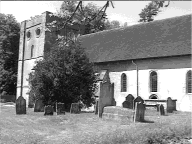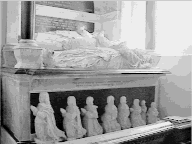![]()

![]()
9. Our Lady of Warnford.

Warnford lies in the heart of the Meon Valley on the A32 between Exton and West Meon but this historic old church is not easy to find. It is built in the heart of the Warnford Estate and cannot be seen from the road.
It can only be approached by a winding driveway through the fields, past herds of grazing cows and over the Meon River. Even then the formidable 50 foot Norman tower dating from 1130 is barely visible, close to a farm and surrounded by huge chestnuts, limes and elms. It really is a church in the middle of nowhere but that adds to its attraction.
The first church on the site was founded by St Wilfrid in 682 but the present church largely dates from 1190 when it was rebuilt on orders of Adam de Port who was Lord of the Manor. This is commemorated by a Latin inscription over a doorway on the north side of the church which reads "May the race signed with the Cross from the rising of the sun bless Adam de Port by whom I have been thus restored."
As you enter through the South Porch notice the Saxon Sundial above the door. Under it, carved in medieval Lombardic script, is another inscription in honour of the founders. In translation it reads "Brethren, bless in your prayers the founders young and old of this temple; Wulfric founded it; good Adam restored it."
Once inside the church observe the large 12th century font of Purbeck stone and the Jacobean Tower Screen guarding the belfry tower where hang six ringing bells all new-cast in 1959. On the south wall is a copy of the will of Thomas Sylver dated 1544 which gives proof of the consecrated name of the church, and also various extracts from Domesday Book relating to Warnford.
Also near the tower is an attractively carved War Memorial dating from 1974 commemorating John Labarie Tomkinson a wireless operator in a Wellington bomber shot down over Hamburg on 13 March 1941. Remarkably he is the only person from the village killed in the two World Wars. Few villages in the country have been so fortunate. The present altar with its cross and candlesticks was given in 1942 by his family in his memory. The old 17th century altar table stands beside the War Memorial.
The nave is mainly of plain whitewash and not particularly attractive. Two Funeral Hatchments hang on the North wall as well as the Royal Arms of George IV.

The Jacobean Chancel Screen dates from 1634 but the chancel itself is dominated by a very large monumental tomb in honour of Sir Thomas Neale, Auditor of the Exchequer under Queen Elizabeth I and James I. He died in 1621. There he lies, serene in his knightly armour, with his two wives Elizabeth and Mary on either side. Underneath nine of his ten children are depicted, four of them carrying skulls to show that they died in infancy. On the other side of the altar is a smaller tomb in memory of his father William Neale. The 12th century east window is of plain glass except for two small medallions showing the Neale Arms. Against the north wall of the chancel are three Misere seats.
In the churchyard a holly tree almost hides an amusing tombstone of 1831. On it is a carving of a tree with a sawn-off limb and a skeleton pointing at it, his saw leaning against the tree. This commemorates George Lewis, the estate carpenter, who, despite warnings, would cut down trees on Sundays, until one Sunday a branch fell off the tree and killed him. A salutary warning to all Sabbath breakers.
Also note behind the east end of the church the extensive and impressive ruins of St John House built in 1210 by the St John family who had married into the de Port family. It became a barn in Elizabethan times before falling into ruin in the eighteenth century.
Country Churches written by John Symonds
![]() return to the June 1997 features page
return to the June 1997 features page
![]() return to Home page and main index
return to Home page and main index
page last updated 8 JUNE 1997